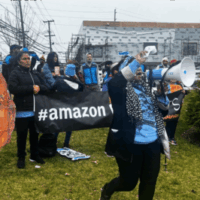A new national report released Wednesday says workers at Amazon’s Minnesota warehouses suffer from a high rate of injury and those at its Shakopee facilities experience large pay gaps by race.
The report — compiled by the National Employment Law Project with assistance from local workers rights group the Awood Center — calls for a state investigation of health and safety hazards at the Amazon facilities as well as an examination of the online retail giant’s practices when it comes to how it monitors and pushes employees’ work speeds.
The report examines data from the U.S. census, the Bureau of Labor Statistics, and the Occupational Safety and Health Administration (OSHA) office. It concludes that despite the rosy picture that Amazon has painted for the public, its continued growth has come with “human costs.”
“The first thing that we realized when we started looking into this is just how off the charts the injuries are,” said Irene Tung, one of the report’s authors and a senior researcher at the New York-based National Employment Law Project.
Amazon declined to comment on the report.
Since it opened its large fulfillment center in Shakopee five years ago, Amazon has continued to expand its physical footprint in Minnesota. This year it opened a fulfillment center in Lakeville. Amazon also recently opened a sortation center in Maple Grove. Over the years, Amazon representatives have said the company has invested more than $3 billion in the state over the years and employed thousands.
Workers at its Shakopee facilities are more than twice as likely to be injured at work as other Minnesota warehouse workers. The report says Amazon reported to OSHA that from 2018 to 2020 Amazon warehouses in Minnesota tallied 792 work-related injuries. The report’s authors analyzed that the rate of injuries at those facilities is 11.1 cases annually per 100 full-time workers, or one injury for every nine workers each year. That’s more than double the rate at non-Amazon warehouses in the state, according to OSHA data.
Many injuries are musculoskeletal disorders caused by repeated lifting, Tung said.
Amazon quotas, which reportedly can include hundreds of items being moved per hour, can be unrealistic, she said. Workers are intensively electronically monitored and then disciplined with that data, Tung said.
“There’s this sense of paranoia,” she said. Workers “just know that they have to be pushing themselves to the brink or they will be fired.”
Emali Pettey, 21, worked at the Shakopee fulfillment center for about a year, but left over the summer after she hurt her back while moving heavy pallets with damaged products.
“I rarely got help,” Pettey said. “I can count on one hand the times that people helped me with pulling.”
Amazon gave her time off after a doctor recommended it, she said. But afterward, the company pulled her from the schedule while Pettey waited to see what would happen to her workers’ compensation claim.
Amazon puts a lot of pressure on managers to make sure they meet performance numbers. In turn, the managers then put pressure on their employees, Pettey said. People don’t have time to stop and help each other with other tasks when they are on the hook for their own, she said.
The report also points to 2018 census data that shows Black workers at Scott County warehouses are paid $2,108 a month, 63% of what white workers are paid. Most of Scott County warehouses, the report said, are Amazon facilities.
Black workers also are overrepresented in the Scott County warehouses: 38% of the warehousing workforce compared with 8% of the total workforce in the Twin Cities, according to the report.
Instead of providing quality, high-paying jobs, the report’s authors conclude that “Amazon has exploited existing labor market inequities to fuel its growth at the expense of the wellbeing of its workers and their families.”
The Awood Center, which has pushed for better treatment of workers who emigrated from East Africa, has staged demonstrations at Shakopee centers over the treatment of workers for “time off task” infractions and during the pandemic has urged for improved workplace safety against coronavirus infection.
“When Amazon came to the Twin Cities, they intentionally and heavily recruited from the East African community,” said Abdirahman Muse, executive director of the Awood Center, in a statement. “Everyone was excited and we were expecting good, safe, reliable jobs. Quickly, we learned that’s not the case at Amazon. As this report shows, Amazon has been reinforcing racial and economic inequities, rather than addressing them.”
The report points to other red flags including high turnover rates (worker turnover in Scott County warehouses was 170% in 2018), lower Scott County warehouse worker wages compared with the statewide average for warehouse workers and other public costs such as air pollution from traffic around Amazon facilities.
The report comes as there has been more emphasis on the treatment of retail workers during the pandemic. Recently, the National Labor Relations Board ordered a new election for Amazon workers in Bessemer, Ala., to vote on whether to form a union after objections that the workers’ first vote wasn’t fair because Amazon’s installation of a mail box at the main employee entrance interfered with the election process.
As it prepared for a busy holiday season, Amazon has pushed to hire thousands in the Twin Cities and across the country. The retailer has made its employee benefits more enticing recently by now offering full-tuition coverage, large bonuses, and higher starting wages.
Pettey said that if she had continued working at Amazon she likely would be making more than she currently does in her new job.
“On paper Amazon does tend to take care of employees, but corporate tends to get in the way,” she said.
Besides changing policies that Amazon can enforce itself, the report’s authors suggested the Minnesota Legislature should convene hearings about Amazon’s role in the state to give the public an opportunity to share their experiences. The report says lawmakers should go as far as adopting legislation to better protect warehouse workers and require employers to disclose productivity quotas. The report also advocates for the state’s OSHA office to conduct inspections of Amazon’s Minnesota warehouses to investigate injuries.
The Associated Press contributed to this report.
Read the full article at Star Tribune



